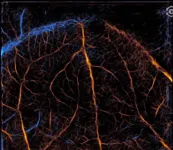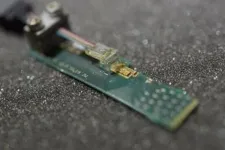(Press-News.org) PROVIDENCE, R.I. [Brown University] — While age-related brain disorders like Alzheimer’s disease often develop slowly across an individual’s lifetime, they usually aren’t detected until symptoms have already started. With that in mind, teams of biomedical researchers led by Brown University scientists have been exploring for years whether devastating neurodegenerative diseases could be caught decades earlier — perhaps through something as simple as a routine eye exam instead of a battery of diagnostic tests.
In a new study, one of the Brown-led teams describes early steps in making that a possibility. They show in Nature Communications that it is possible to track how blood vessels in the brains of mice change over long periods of time. The results begin to give biomedical researchers a tool to identify and study biomarkers in these blood vessels that may hold pivotal clues to early detection of progressive neurodegenerative diseases like Alzheimer’s, Parkinson’s, Huntington’s disease and multiple sclerosis.
The hope is that they can next use their method to image the retina in mice to look for these biomarkers, and from there scale up to imaging the retina of humans to study and track how the blood vessels change. The work is among a number of research efforts by Brown scientists to catch Alzheimer’s early by peeking into the eyes.
“In this paper, we show that using our imaging technology we can image the brain of the same animal over and over again repeatedly for almost one year, measuring the properties of blood vessels of the brain,” said senior study author Jonghwan Lee, an assistant professor in Brown’s School of Engineering and Carney Institute for Brain Science. “The results potentially open a path to being able to predict when someone is at risk for developing these neurodegenerative diseases and for doctors prescribing early treatments for them.”
Tracking how cerebral blood vessels change over extended periods of time in people who develop age-related neurodegenerative diseases, compared to what normal change looks like, has long been a goal for scientists. It’s thought that cerebral blood vessels in people who develop brain diseases show signs of degradation and decline decades before symptoms from the disease begin.
“If we can detect the change in the blood vessels in the brain, or in the retina, for long periods of time, it has long been considered to be possible to predict the onset of these kinds of diseases,” Lee said.
Challenges in current microscopic methods have made this type of longitudinal tracking extremely arduous, however, requiring various workarounds. The research team — which also included scientists from Brown’s Warren Alpert Medical School and School of Public Health — set out to find a more direct approach.
The novel method they created combines advanced imaging techniques and AI algorithms to track changes in the dynamics and anatomy of blood vessels of the brain. The researchers used the method to measure these changes in 25 different mice for more than seven months.
According to the study, the research team focused on a non-invasive imaging test called optical coherence tomography. OCT uses light waves to look through the retina and image blood vessels that surround the optic nerve. The team adapted multiple OCT techniques to image brain blood vessels like pial vessels, cortical vessels and capillary network. They then integrated the OCT methods with image processing algorithms to search for patterns in the data they collected from normal mice and Alzheimer’s disease model mice.
Analyzing the data, they noticed differences between normal age-related changes and vascular changes brought on by disease.
“We found several candidate biomarkers like large blood vessels getting thinner and blood flow getting lower, and, more interestingly, the network pattern of vessels significantly altering, compared to the normal aging animals,” Lee said.
The ultimate goal is to fine-tune the method and gather enough data so that the group’s algorithms can analyze and predict through regular eye exams the chance of a person developing neurodegenerative diseases years before they do. The team is a long way off from this goal but is off to a strong start with the proof of concept in mice, which act as model organisms. In the coming years they plan to look closer at the biomarkers they found and identify more. The next step is imaging blood vessels in the retinas of mice.
The work was co-led by Warren Alpert Medical School student Konrad W. Walek, while he was an undergraduate in Brown’s Department of Neuroscience, and Sabina Stefan, while she was a graduate student at Brown’s School of Engineering. Both worked in Lee’s lab. Other Brown authors include Jang-Hoon Lee, Anna H. Kim, Seong Wook Park, Tao Liu, Yu-Wen Alvin Huang and Christopher Moore.
The work was supported by the National Institute on Aging.
END
New method tracking changes in blood vessels could advance brain disease detection
A new imaging technique opens a path toward long-term study of blood vessels in aging brains and could help predict neurodegenerative diseases decades before symptoms begin
2023-05-25
ELSE PRESS RELEASES FROM THIS DATE:
New framework for super-resolution ultrasound
2023-05-25
Researchers at the Beckman Institute for Advanced Science and Technology used deep learning to develop a new framework for super-resolution ultrasound.
Traditional super-resolution ultrasound techniques use microbubbles: tiny spheres of gas encased in a protein or lipid shell. Microbubbles are considered to be a contrast agent, which means they can be injected into a blood vessel to increase the clarity of an ultrasound image.
Conventional ultrasound has been commonplace for over 50 years. The development of super-resolution technology in the last decade has introduced new challenges. Super-resolution ultrasound provides a much clearer picture than the traditional method. ...
Simon Fraser University becomes global instructor training facility for Siemens mechatronic systems certification program
2023-05-25
Responding to a growing need for training in automation systems in Canada and globally, Siemens and Simon Fraser University (SFU) have announced that SFU is the first and only training facility for instructors delivering the globally recognized Level 3 Siemens Mechatronic Systems Certification program (SMSCP). Instructors, upon completion of the two-week long training will be qualified to deliver the Level 3 certification mechatronics training, vital for providing students with real-world technical skills, and helping prepare them to thrive in a high-tech world of work. Level 1 and Level 2 ...
Reconstructing brain connectivity using 3D images
2023-05-25
Dr. Shuiwang Ji, a professor in the Department of Computer Science and Engineering at Texas A&M University, is part of a collaborative research community that recently had its paper titled “BigNeuron: a resource to benchmark and predict performance of algorithms for automated tracing of neurons in light microscopy datasets” published in the April issue of the journal Nature Methods.
Initiated in 2015 and led by the Allen Institute for Brain Science, BigNeuron is an international initiative that brings together computer scientists and neuroscientists from a dozen institutions. ...
Words matter: How researchers can avoid stigmatizing language
2023-05-25
Word choice matters—a lot— when it comes to research. That’s the main takeaway from a new article co-authored by Edson College of Nursing and Health Innovation Assistant Professor Angel Algarin and published in Health Communication.
“Researchers in any field should be cognizant of the language they’re using to describe the people they study so they don’t inadvertently add to the use of stigmatizing language,” said Algarin.
For the article, Algarin and his co-authors performed a content ...
Chip-based QKD achieves higher transmission speeds
2023-05-25
WASHINGTON — Researchers have developed a quantum key distribution (QKD) system based on integrated photonics that can transmit secure keys at unprecedented speeds. The proof-of-principle experiments represent an important step toward real-world application of this highly secure communication method.
QKD is a well-established method of providing secret keys for secure communication between distant parties. By using the quantum properties of light to generate secure random keys for encrypting and ...
The brain’s protein-destruction machine learns new tricks at synapses, revealing a potential target for treating neurological disorders
2023-05-25
Darwin’s theory of evolution highlighted the importance of adaption and diversity in the natural world. Inside a biological cell, can proteins also perform new functions in new contexts? The answer seems to be yes for the brain’s primary protein-degradation machine, especially when it is placed at synapses, revealing a hitherto unknown mechanism that allows synapses to change in response to different circumstances.
The role of the regulatory (19S) proteasome particle has always been exclusively linked to its functioning in the proteasome complex, where it collaborates with the catalytic (20S) particle to recognize ...
Polar fish are less likely to die early, so they prioritize growth over reproduction
2023-05-25
Polar fish experience lower mortality than tropical fish, allowing them to delay reproduction until later in life when they are larger and can produce more eggs, according to a study by Mariana Álvarez-Noriega at Monash University in Australia and colleagues, publishing May 25th in the open access journal PLOS Biology. This may have implications for the effects of climate change on the sustainability of fish populations.
Organisms face a trade-off around when is the best time to reproduce. Fish continue to grow throughout life and larger fish tend to produce disproportionately more eggs than smaller fish, so it ...
Arctic ground squirrels changing hibernation patterns
2023-05-25
Arctic ground squirrels are unique among mammals. Their ability to keep from freezing even when body temperatures dip below that mark on the thermometer enables them to survive extreme winter climates. New research published in Science analyzes more than 25 years of climate and biological data. The findings include shorter hibernation periods and differences between male and female hibernation periods. Spoiler alert - the girls “rise and shine” a little earlier in response to warming, which could have both positive and negative ripple effects throughout the food web in these ecosystems.
Senior ...
As Arctic warms, female arctic ground squirrels end hibernation before males – a mismatch with consequences
2023-05-25
As Alaskan permafrost warms, hibernating arctic ground squirrels generate less heat, causing females to emerge from hibernation up to 10 days before their male counterparts – a mismatch that could have large, cascading ecological impacts. The findings of the related study reveal both direct and indirect impacts of a warming world. Winter temperatures play a fundamental role in fitness and population dynamics for many species that live in higher latitudes. However, in the Arctic, where warming is occurring more rapidly than most other places on ...
Stressed soil microbial communities bolster tree resilience to changing climates
2023-05-25
Soil microbiota transplanted from more stressful environmental conditions – drought or excessive heat or cold, for example – can enhance tree tolerance to changing climates, researchers report. The findings suggest that management of soil microbiota, especially during forest restorations, could be a valuable strategy for increasing forest resilience to climate change. Climate change is forcing many species outside of their evolved range of environmental tolerances, forcing them to acclimate, adapt, or migrate to avoid extinction. For long-lived ...
LAST 30 PRESS RELEASES:
Press registration is now open for the 2026 ACMG Annual Clinical Genetics Meeting
Understanding sex-based differences and the role of bone morphogenetic protein signaling in Alzheimer’s disease
Breakthrough in thin-film electrolytes pushes solid oxide fuel cells forward
Clues from the past reveal the West Antarctic Ice Sheet’s vulnerability to warming
Collaborative study uncovers unknown causes of blindness
Inflammatory immune cells predict survival, relapse in multiple myeloma
New test shows which antibiotics actually work
Most Alzheimer’s cases linked to variants in a single gene
Finding the genome's blind spot
The secret room a giant virus creates inside its host amoeba
World’s vast plant knowledge not being fully exploited to tackle biodiversity and climate challenges, warn researchers
New study explains the link between long-term diabetes and vascular damage
Ocean temperatures reached another record high in 2025
Dynamically reconfigurable topological routing in nonlinear photonic systems
Crystallographic engineering enables fast low‑temperature ion transport of TiNb2O7 for cold‑region lithium‑ion batteries
Ultrafast sulfur redox dynamics enabled by a PPy@N‑TiO2 Z‑scheme heterojunction photoelectrode for photo‑assisted lithium–sulfur batteries
Optimized biochar use could cut China’s cropland nitrous oxide emissions by up to half
Neural progesterone receptors link ovulation and sexual receptivity in medaka
A new Japanese study investigates how tariff policies influence long-run economic growth
Mental trauma succeeds 1 in 7 dog related injuries, claims data suggest
Breastfeeding may lower mums’ later life depression/anxiety risks for up to 10 years after pregnancy
Study finds more than a quarter of adults worldwide could benefit from GLP-1 medications for weight loss
Hobbies don’t just improve personal lives, they can boost workplace creativity too
Study shows federal safety metric inappropriately penalizes hospitals for lifesaving stroke procedures
Improving sleep isn’t enough: researchers highlight daytime function as key to assessing insomnia treatments
Rice Brain Institute awards first seed grants to jump-start collaborative brain health research
Personalizing cancer treatments significantly improve outcome success
UW researchers analyzed which anthologized writers and books get checked out the most from Seattle Public Library
Study finds food waste compost less effective than potting mix alone
UCLA receives $7.3 million for wide-ranging cannabis research
[Press-News.org] New method tracking changes in blood vessels could advance brain disease detectionA new imaging technique opens a path toward long-term study of blood vessels in aging brains and could help predict neurodegenerative diseases decades before symptoms begin



